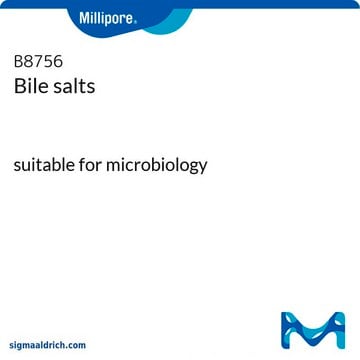This product meets 4X the minimum USP specifications. According to the USP monograph for Pancreatin, the 1X minimum specification is 25 USP units amylase, 2 USP units lipase, and 25 USP units protease per milligram. The calculated protease activity for the 4X preparation then, would be at least 100 units per milligram. This is a calculated value based on the USP monograph and are not reported separately on the Certificate of Analysis.
P1750
Pancreatina from porcine pancreas
4 × USP specifications
Sinónimos:
Pancreatina from hog pancreas
About This Item
Productos recomendados
Agency
USP (specifications)
Nivel de calidad
Formulario
powder
actividad específica
4 × USP specifications
contiene
lactose or sucrose as extender (The sucrose used might contain up to 3.25% starch.)
temp. de almacenamiento
−20°C
¿Está buscando productos similares? Visita Guía de comparación de productos
Categorías relacionadas
Aplicación
- for a study to assess the treatment of steatorrhea by lipase supplementation therapy[1]
- for a study to investigate treatment options for pancreatic diabetes in patients experiencing the decompensated stage of chronic pancreatitis[2]
- to safely and effectively remove formalin-fixed tissues from arterial grafts without causing structural damage and loss in fiber integrity [3]
- to assess cleavage by digestive enzymes.
- for in vitro digestibility analysis and to test the sensitivities of cellulolytic bacteria inhibitors.[4]
- along with amyloglucosidase for the in vitro digestion of starch in food samples.[5]
Acciones bioquímicas o fisiológicas
Palabra de señalización
Danger
Frases de peligro
Consejos de prudencia
Clasificaciones de peligro
Eye Irrit. 2 - Resp. Sens. 1 - Skin Irrit. 2 - Skin Sens. 1 - STOT SE 3
Órganos de actuación
Respiratory system
Código de clase de almacenamiento
11 - Combustible Solids
Clase de riesgo para el agua (WGK)
WGK 2
Punto de inflamabilidad (°F)
Not applicable
Punto de inflamabilidad (°C)
Not applicable
Elija entre una de las versiones más recientes:
Certificados de análisis (COA)
¿No ve la versión correcta?
Si necesita una versión concreta, puede buscar un certificado específico por el número de lote.
¿Ya tiene este producto?
Encuentre la documentación para los productos que ha comprado recientemente en la Biblioteca de documentos.
Los clientes también vieron
-
units of pancreatin cas number 8049-47-6
1 answer-
Helpful?
-
-
What is the trypsin activity of this P1750 product ?
1 answer-
This product is not specifically tested for trypsin activity. The material meets USP requirements. This monograph includes testing for protease, amylase, and lipase.
Helpful?
-
-
What is the solubility of p1750 pancreatin in water?
1 answer-
This product is soluble at 7 mg/mL in water and may yield a hazy solution.
Helpful?
-
-
As per USP: Pancreatin contains, in each mg, not less than 25 USP Units of protease activity. I assume that product P1750 contains minimum 100 USP units of protease activity in each mg. What is the maximum USP units of protease activity in P1750 ?
1 answer-
Yes, this is correct. To meet the USP specifications, the protease activity will be less than 100 USP Units/mg.
Helpful?
-
Active Filters
Nuestro equipo de científicos tiene experiencia en todas las áreas de investigación: Ciencias de la vida, Ciencia de los materiales, Síntesis química, Cromatografía, Analítica y muchas otras.
Póngase en contacto con el Servicio técnico









